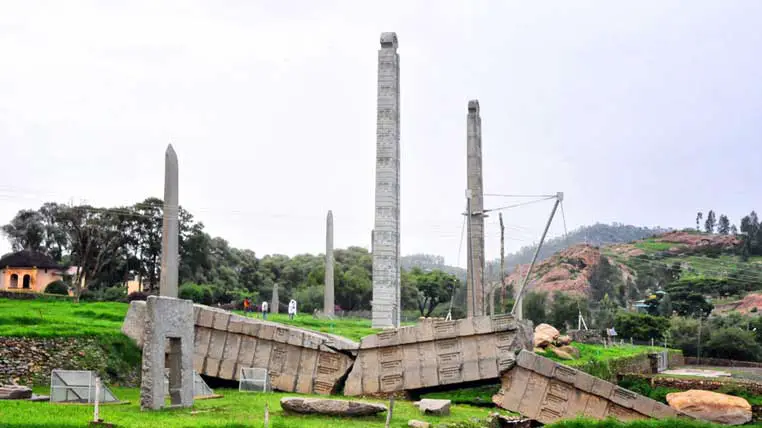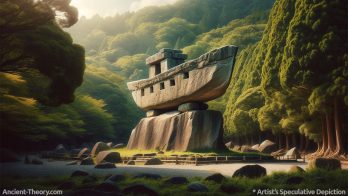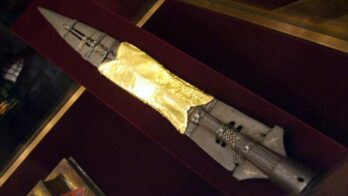The Obelisks of Aksum (Axum) served as markers for important graves and religious sites, as well as symbols of the power and wealth of the Aksumite empire.
Some obelisks were taken from Aksum as loot by foreign powers, while others were destroyed over time by war, weather, and other factors.
However, several obelisks still stand in Aksum today and are recognized as important cultural and historical artifacts.
The Obelisks of Aksum - Remnants of an Unknown Civilization?
The Kingdom of Aksum, an ancient civilization that emerged in Ethiopia during the early 1st century AD, was one of the most powerful and influential kingdoms in Sub-Saharan Africa.
This prosperous African civilization controlled a vast commercial network that connected the Roman Empire to the Middle East and India. It was home to an impressive metropolis with an estimated population of 20,000.
Aksum was a significant economic, military, cultural, and religious center known for its elaborate monuments and for being the first to introduce Christianity to Sub-Saharan Africa.
One of the most fascinating and enigmatic monuments is the Aksum Obelisks, crafted using mysterious building techniques.
Local legends suggest that the ancestors of the inhabitants of Aksum possessed the ability to melt stone, pour it into long wooden shapes, and chisel, polish, and transform it into various massive forms such as monoliths, columns, and obelisks.
However, modern science has dispelled the notion that stone can be melted, leaving this an enigma that has long fascinated scholars.
The Aksum Obelisks are made of blue-grey basalt and come in various shapes and sizes, with the tallest preserved column measuring 110 feet (33.5 meters).
In total, there are more than 200 distinct basalt monoliths, ranging from slim and elegant, splendidly polished and richly ornamented, to intentionally primitive and coarse.
Despite the significant progress made by Aksumology, a branch of Orientalism that focuses on studying the Kingdom of Aksum, much about this civilization’s past still needs to be explored.
The origin and destination of the Aksum Obelisks remain a significant challenge for archeologists and historians, leading to theories about an unknown civilization that may have preceded the Aksum civilization by centuries, if not millennia.
These people may have been responsible for crafting the first monoliths with remarkable skill, which the successors of the Aksum civilization then tried to reproduce using the tools available to them.
A Powerful Ancient African Kingdom
Tsegai Nebeibeh, one of the most renowned Aksumologists, believes that many myths and legends surrounding the city of Aksum originated from Biblical times.
According to legend, the country’s central city was called Sheba and was ruled by a giant dragon or serpent that demanded sacrifices in the form of animals and girls from its subjects.
One of the unfortunate girls chosen to become a victim of the tyrant was a beautiful young woman loved by the hero Agaboz.
The young warrior killed the monster to save his beloved, and the people proclaimed him king. After him, his daughter, the intelligent and cultured Makenda, became queen of Sheba and was known as the Queen of Sheba.
Today, Aksum has a population of around 5,000, including approximately 1,000 monks. It is hard to imagine that Aksum was once the center of one of the most powerful states of ancient times.

One of the first pieces of information about Aksum and many other towns in East Africa comes from the famous Periplus of the Erythraean Sea, probably the oldest “travel guide” written around 60 AD.
The manual’s title speaks for itself, as the Erythraean Sea was the old name for the Indian Ocean, and Eritrea was a part of the Aksum state.
The powerful ancient kingdom left behind grand architectural monuments created with a technique that remains a mystery today. Aksum conquered vast territories, controlled both sides of the Red Sea, and had a powerful fleet.
At the time, Aksum was such a powerful state that it was on an equal footing with countries such as Byzantium and India, a fact confirmed by the writings of the Arab historian Mani, who, in the third century AD, mentioned that there were four empires in his time: Aksum, Babylon, Rome, and Egypt.
The powerful African kingdom owed its fame and wealth to its strong religion and army.
Its territory had numerous palaces and churches, attracting foreign travelers who were amazed by their beauty. The colossal wealth and imposing monuments spread the fame of Aksum all over the world.
This is the era in which the grand “Aksum Obelisks” appeared in the great African capital. Although there is no concrete evidence, many researchers believe these imposing obelisks were erected to honor the army.
Explorers who explored the South African jungle discovered the existence of enormous elliptical constructions, stone temples, and cities with solid walls around them, for which massive blocks of hard stone were used, perfectly interlocked without mortar.
Later, it was possible to ascertain that these were the ruins of the capital of the great mining empire of Zimbabwe, located in the region between the Limpopo and Zambezi, the two great African rivers.
At first glance, the cities of Zimbabwe and the obelisks of Aksum may seem to share only two common features: their enigmatic character and the immense scale of the structures.
However, other mysterious cities, such as Angaruka, were discovered by chance in 1935 by a colonial official somewhere in Tanzania, and professor L. Leakey later studied their ruins.
The Mysterious Ruins of Angaruka
Leakey observed that ancient builders constructed imposing temples in Angaruka and Zimbabwe without using mortar or anything else to hold the giant stone blocks together.
Recently, the Department for the Protection of Ancient Monuments of Tanzania has carried out a series of excavations at Angaruka, unearthing shell necklaces and establishing a connection between the city and the ocean shore.
This raises the question of whether the walls of Jilbaba and the ruins of Angaruka were vestiges that linked Aksum to Zimbabwe.
The Obelisks of Aksum sprout from the ground, appearing to have a natural foundation at their base. However, as archaeologists discovered, things were not as they seemed.
In the early 1970s, a Franco-Ethiopian archaeological expedition excavated for two years, including in the center of the Aksum star park, and made a sensational discovery.
They found coins, clay vessels, and a series of ancient household objects at the base of a once massive construction while removing layers of earth and clay.
Until then, it had been believed that the Obelisks of Aksum were raised on a natural mound known as the Beta-Ghiorghios hill, covered with grass and crisscrossed by paths in all directions.
However, the excavations revealed that the hill had once been an immense 125 yards (about 115 meters) long platform made up of carved basalt slabs.
Three terraces were built on the slopes of the hill, creating the illusion of stepped foundations.
Thus, the remarkable discovery was made that the Obelisks of Aksum might represent the upper part of a giant structure buried in the ground.

Taakha-Maryam
Throughout history, countless monuments of priceless value to world culture have been destroyed during military conflicts.
The ruins of the Taakha-Maryam church were no exception and were subjected to aerial bombardment during the Fascist aggression war of Italy against Ethiopia in 1938.
Fortunately, shortly before these bombardments, archaeologists uncovered the foundation of the old temple, allowing for a first reconstruction.
It was later discovered that Taakha-Maryam, located near the Aksum Star Park, had been a much larger building than that found on the Beta-Ghiorghios hill.
Initially, Taakha-Maryam was the luxurious residence of unknown ancient rulers venerated by the people, and later became a temple.
The Taakha-Maryam building measured 130 yards (about 120 meters) in length and 87 yards (about 80 meters) in width, with over a thousand halls and bedrooms.
The floor was made of green marble and rare red and pink wood. The walls were lined with ebony wood, dark marble, and gilded bronze inlays.
The windows and doors were decorated with bas-reliefs, and the rooms were adorned with bronze sculptures and ceramic vessels.
In terms of size, only Husumi-Kubwa from Kilwa and famous Zimbabwe could compete with Taakha-Maryam. However, the palace in Aksum remains unparalleled throughout tropical Africa.
Judging by the ruins of the foundations discovered, we are left wondering how many floors the giants of this area could have had.
Archaeological findings from half a century ago lead us to believe that the structures in Aksum resembled those of the city’s former buildings, including palaces with 4, 6, 12, and 14 floors.
The Difficult Techniques Used to Construct the Monoliths
The monoliths in Aksum replicate the palace’s details on a smaller scale.
A single floor could measure up to 9 feet (2.8 meters) in height, making a 14-floor palace approximately 130 feet (40 meters) high.
These buildings are true skyscrapers built at the beginning of the Christian era, far from Athens, Rome, and Babylon.
One question that naturally arises is what level of development the ancient African state had achieved to allow for the manipulation of vast masses of builders and materials, mainly of perfectly polished massive stone slabs, without needing mortar to fix them.
In the late 19th century, the British archaeologist Bent discovered traces of large stone quarries in Godebra, about 1.7 miles (6 kilometers) northwest of Aksum. From there, Aksum stonemasons cut blocks of basalt using a lost technique.
Halfway between the quarry and the city, Bent found a huge carved stone block left on the road that the builders, for unknown reasons, could not use in their impressive constructions.
The question of how the builders transported and raised blocks of stone weighing several tons remains an obsession, as it does with the giant pyramids of Egypt.
Nannos, a soil of the Byzantine Emperor Justinian, mentioned in his writings that the King of Aksum traveled in a gilded carriage and his courtiers in silver carts, all pulled by elephants.
People may have managed to tame elephants, and the traction force of these animals was used to transport the granite and basalt blocks.
Another question is how the roads’ infrastructure could withstand the transport of such colossal blocks.
At Ancient Theory we only use trusted sources to document our articles. Such relevant sources include authentic documents, newspaper and magazine articles, established authors, or reputable websites.
- Michael Marshall - Lost Ethiopian town comes from an ancient empire that rivaled Rome. newscientist.com.
- Kingdom of Aksum. wikipedia.org. [Source]
- David W. Phillipson - Foundations of an African Civilisation: Aksum & the Northern Horn, 1000 BC-AD 1300. Woodbridge: James Currey, 2012.
- The Monumental Stelae of Aksum (3rd–4th Century). The Metropolitan Museum of Art. [Source]
- Obelisk of Axum. wikipedia.org. [Source]
- The Kingdom Of Aksum. The National Geographic. [Source]
- Carly Cassella - Lost City Discovered Beneath Ethiopia Was Once a Pillar of The Legendary Aksum Empire. sciencealert.com.
- Bipin Dimri - What Happened to Aksum, the Fourth Great Empire of the Ancient World? historicmysteries.com.






